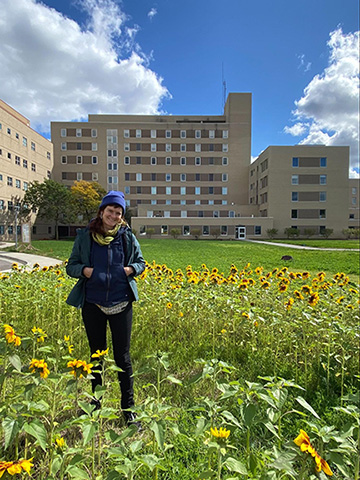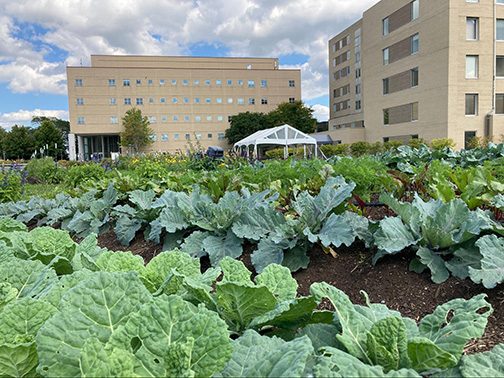
 back to all news
back to all news
MLA alumna helps design therapeutic green space for local hospital

Kat Shiffler (MLA ’21) began volunteering at the Farm at St. Joe’s soon after landing in Ann Arbor to pursue a master’s degree in landscape architecture at the U-M School for Environment and Sustainability (SEAS). A nonprofit teaching hospital located on 340 acres—the largest hospital campus in the country by area and a former dairy farm—St. Joe's is home to The Farm, where the therapeutic modality of "green care" approaches wellness through the act of growing food. When farm staff approached Shiffler to help design a new hospital-based farm at St. Joseph Mercy Oakland in Pontiac, Michigan, she recognized the opportunity to contribute directly to the organization’s innovative vision.

The site plan developed into three main areas: a hospital-based farm, aesthetic green space, and community flower garden. The hospital-based farm has been developed and is being used to supplement food-insecure families in the surrounding community. The community flower garden was planted with species native to Michigan along with colorful annuals, and is open for the public to admire and pick their own bouquets. An aesthetic green space is still under development, but will have different native species, benches, shaded areas, and walking paths for patients and staff to relax in.
Patients receive prescriptions for vegetables grown on the farm, accompanied by nutrition education, while emergency-room staff garden together to relieve job-related stress. Inside the county's first accessible greenhouse, said Shiffler, traumatic brain injury patients garden to re-learn motor skills—and take home the fruits and vegetables of their labor.
“There was a challenge to implement a landscape that is welcoming, especially with a large looming hospital structure next to the future garden area. We want this space to be welcoming to both individuals within the hospital, as well as Pontiac community members,” said Shiffler. “Experiences in these spaces can elicit well-being responses, and I really wanted to make this a healing space that enhanced a patient or medical worker’s experience at the hospital itself.”
The Covid pandemic also proved to be a challenge, added Shiffler. “Once the pandemic started it halted some of our initial plans for the site, but it allowed us to use the site to boost the environmental emotional support for those working tirelessly at the hospital. We decided to plant 2,000 sunflowers for workers, patients, and their families to enjoy. This initiative then turned into a permanent installation, a flower garden where patient families are encouraged to cut flowers and then give them to their loved ones in the hospital.”
A trip to Santiago, Chile, in Winter 2019 inspired Shiffler to contemplate how best to make the St. Joseph Mercy Hospital project an interactive experience deeply tied to the healthcare experience and horticulture therapy of the site. “During my trip, I toured well-known hospitals and their associated healing spaces, especially green spaces, within those hospital settings. It really showed me the ways that green spaces can be utilized across different cultural contexts, and it was a wonderful way to study real-world examples of the green care movement.”

Shiffler’s passion for landscape architecture was largely inspired by the capacity for green spaces to be an active part of community generation and the therapeutic benefits of environmental designs. She was particularly influenced by SEAS Landscape Architecture Professor Emerita MaryCarol Hunter’s research on “the nature pill” and the psychological benefits of natural and manmade green spaces. Dr. Hunter’s research reinforces that experiences in nature reduce stress even in urban settings.
Shiffler has taken her passion for community environmental projects into her work as a landscape architect for the National Park Service (NPS) within the Rivers, Trails, and Conservation Assistance program (RTCA). “RTCA is like the community design wing of the NPS, and my job is to provide technical design assistance to communities to support local initiatives for new or improved natural areas and recreation experiences. It's about ensuring that everyone has access to therapeutic nature in some shape or form—from a kayak launch to a new bike trail to an urban garden,” said Shiffler.
“My current job is focused on working with communities that are trying to expand conservation or cultivate natural spaces,” she added. “I like to consider how we can involve people in the construction and benefit of a landscape. What can we do besides just building another parking lot? Can urban farms benefit people as much as an old growth forest? Many communities are unable to visit national parks because of inaccessibility, and fostering local and urban natural areas is an important way to expose people to inspiring natural settings that are accessible and close to home.”
Reflecting on her time working with the Farm at St. Joe’s, Schiffler noted “it was a special opportunity to design an engaging landscape that serves a hospital community with the addition of healthy food, peaceful places, and beauty. As designers, we can help institutions and communities envision the possibilities beyond the lawn.”

